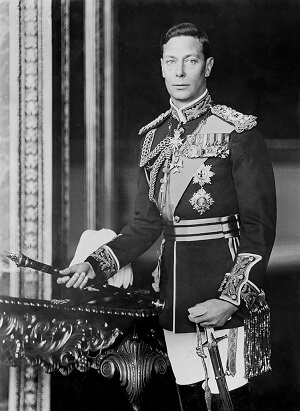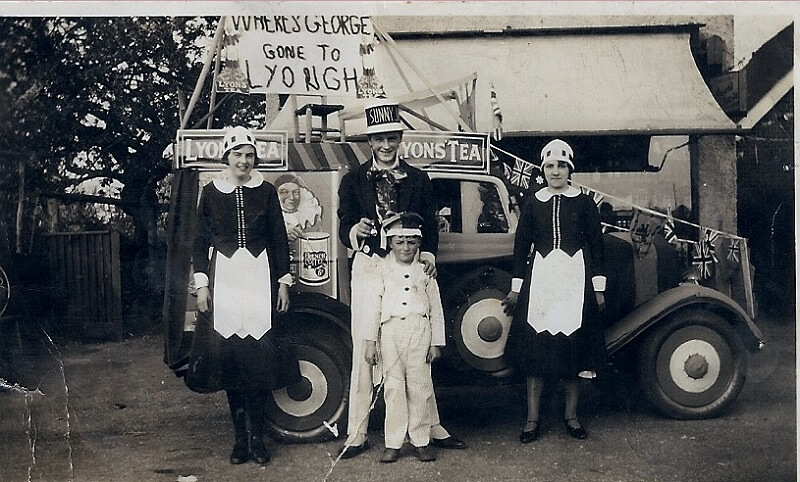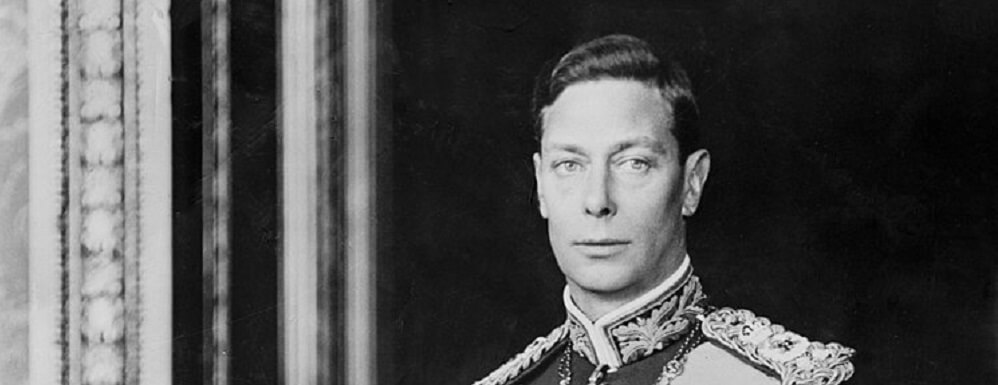GEORGE VI

George V died in January 1936 and the next Coronation was planned for 12 May 1937. Pupils at St Mary’s School listened on the radio to hear the proclamation of the new king, George’s eldest son David who was to be crowned as King Edward VIII. However, on 11 December 1936, the King announced that he had abdicated the throne so that he was free to marry Mrs Wallis Simpson, the woman he loved.
Edward’s younger brother, Albert, would become king. There was no change to the planned date for the Coronation. George VI, as he wished to be known in deference to his father, became King at the end of his 40th year and preparations were planned quickly to move things forward.
The ceremony was attended by the King’s and Queen’s daughters, Princesses Elizabeth and Margaret, as well as by the King’s mother, Queen Mary, the first British dowager queen to do so, all as a show of support to George. Members of the extended royal family attended and all peers and members of parliament were invited. Leading colonial administrators, ambassadors, Indian princes and premiers of the dominions were also on the guest list. Working-class representatives included representatives of the trade unions and co-operative societies, while native Africans were invited to attend for the first time. Expertise in how to organise a Coronation was developing! Three days holiday for the coronation were added to the Whitsuntide break for the school children.
A week after the Coronation, the Empire Coronation Rally of Youth, an event for young people of the Empire was staged at the Royal Albert Hall, attended by representatives from all over the emerging Commonwealth. Read an account of this written by two pupils from Dr Challoners School. Further Reading Empire Coronation Rally of Youth
George had never enjoyed good health, had grown up in the shadow of his older brother, David (Edward VIII) and his debilitating stammer was a cause for concern. The Oscar-winning film ‘The King’s Speech” documents the remarkable work of an Australian speech therapist, Lionel Logue, to help the King, ably assisted by his wife, to overcome his disability. Despite that, however, other events combined to ensure his popularity. He had become known as “the industrial Prince” following his earlier practice of visiting factories, coal mines and other such establishments and with the onset of war, the Royal Family received a demonstrable sense of purpose.
George introduced the George Cross and the George Medal to recognise acts of exceptional courage principally by civilians. As the idea of Empire was in decline, he focused increasingly on the creation of the Commonwealth, a concept later promoted by his daughter, Queen Elizabeth.

Buckingham Palace was bombed nine times but the King refused to leave. Memorably, his wife, Queen Elizabeth said “Now we can look the East End in the face” after one such raid. In response to a suggestion that they might leave London and go to one of the dominions, her response was “The children won’t leave without me. I won’t leave without the King. And the King will never leave.”
The arrival of Churchill as Prime Minister in 1940 saw the development of a close and successful relationship between the two leaders for the rest of the war.
George VI was crowned as the last Emperor of India and the first Head of the Commonwealth. His daughter, the future Queen Elizabeth was the first female member of the Royal Family to enlist, when she joined the ATS at the age of 18.
George’s failing health was not made public, in contrast to the manner in which his grandfather, Edward VII ’s illness had stunned the public 50 years earlier, and despite his desire to develop the Commonwealth he was increasingly unable to travel. His daughter undertook a proposed trip to Australia and New Zealand in his place but this was unexpectedly curtailed when he died in February 1952, five months after he had a lung removed. She returned home quickly from a brief stop in Kenya, as is well documented.
CORONATION OF 1937
Buckinghamshire Advertiser Friday 21 May 1937
Revelry in Amersham High Street Residents Dance and Sing amid Illuminations
The gayest place locally on Saturday was Amersham, where hundreds of residents in fancy dress after parading the main thoroughfare in a torchlight procession, sang and danced to music provided by Amersham Town Band under the leadership of Deputy Bandmaster L Keen and the Minstrels. The idea was one that came on the spur of the moment and emanated from Tom Bailey’s Minstrel Troupe which sprang into existence some time ago, and Mr Bailey had the assistance of Mr F Nutkins. ‘We thought it would be a good idea to finish up with singing and dancing in the streets after the torchlight procession the same as we did at the Jubilee time’
Mr Nutkins said, commenting upon the success of the venture. All the minstrels were effectively disguised and played various instruments. The procession turned up near the Chequers , a much bewigged Mr F Gomm leading the way. Behind him came: Amersham Fire Brigade with engine, in charge of Supt. Line; Amersham Town Band; and many people in fancy dress depicting Charlie Chaplin, proprietary articles, Coronation Colours, Britannia, chimney sweeps, clowns, pierrettes, etc. Paying a visit first of all to the Institution, the procession later marched to the extreme end of town, where the torches were lighted (a galaxy of small boys and yeoman work as torch bearers) and the company returned to the widest part of the street, where a halt was called and the singing and dancing indulged in. Looking extremely smart in their new uniforms, Special Constable Inspector H S Cox (Chesham) Sergeant Eden and Constable H Freeman gave the regular police – who were represented by Inspector Tobin, Sergeant Roworth, and Police Constable Hussey – invaluable help in controlling the large crowd and traffic.
Practically every building was illuminated with exterior lights whilst the council offices were flood lighted and the two bands, leading the dancing and singing which was indulged in by the many people in fancy dress, made a very animated scene. Amersham Town Band also accepted an invitation to play at Little Missenden on Monday night, when the bonfire and fireworks, postponed from Coronation Day on account of the bad weather, were lighted. Mr Bailey and Mr Nutkins asked us to give thanks for them, all who helped to make the Saturday evening’s revels such a success. The musicians gave their services gratis.
Coloured lights as decoration
The idea of promoting the event using electrically decorated lights had been a topic of discussion tn the Press . On 23 February. 1037, a correspondent from Chorleywood wrote in to the Bucks Examiner to encourage the use of electrical coloured lights and to say “I can see some very beautiful effects if strings of decorative lights, even more simply, coloured electric bulbs were hung up in cottage windows or placed amongst the flowering plants and window boxes and so forth” Red, white and blue were the obvious suggestions.
FANCY DRESS
The Empire theme seemed to attract popular imagination. Barn Meadow was the site for the Fancy Dress procession and judging, and these photographs illustrate the enthusiasm of the entrants , all in Barn Meadow.
AROUND AND ABOUT
Winchmore Hill was a local village that joined in the celebrations enthusiastically.
BUCKS EXAMINER 5 FEB 1937 WINCHMORE HILL
THE CORONATION. On Thursday last a general meeting. was held in the Memorial Hall, and arrangements for the celebration of the Coronation were discussed. It was decided that a house-to-house collection would be necessary to provide the funds needed, and that all contributions would be gratefully received. The general plan for the celebration is : An openair service ; sports ; a tea for children at which souvenir mugs will be distributed; a tea for adults ; fireworks ; and a dance or concert in the Memorial Hall to conclude the day’s entertainment. The final arrangements will be made as soon as the amount of funds available is made known.

Maureen Grover remembers “There was a tree planted on Chesham Bois common to celebrate the coronation of George VI. I was there. Every child was given a coronation mug. There were side shows and I with others danced round a Maypole. My parents and I went to the Mall later and called for the King. He did not come by nine o’clock. We had to leave as the last train to Amersham was about to depart. He came onto the balcony half an hour after we left!!”

Sources
British Newspaper Archive
Wikipedia
The Shortest History of the Crown Stephen Bates
Images
Amersham Museum
Bucks Archive
Dr Challoners School Amersham
Amersham Band

